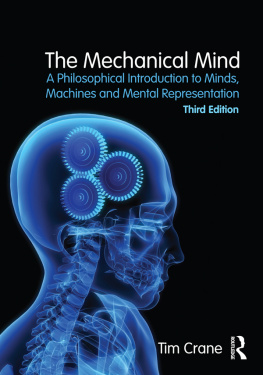SURFING UNCERTAINTY
Surfing Uncertainty
Prediction, Action, and the Embodied Mind
Andy Clark


Oxford University Press is a department of the University of Oxford. It furthers the Universitys objective of excellence in research, scholarship, and education by publishing worldwide.
OxfordNew York
AucklandCape TownDar es SalaamHong KongKarachi
Kuala LumpurMadridMelbourneMexico CityNairobi
New DelhiShanghaiTaipeiToronto
With offices in
ArgentinaAustriaBrazilChileCzech RepublicFranceGreece
GuatemalaHungaryItalyJapanPolandPortugalSingapore
South KoreaSwitzerlandThailandTurkeyUkraineVietnam
Oxford is a registered trademark of Oxford University Press in the UK and certain other countries.
Published in the United States of America by
Oxford University Press
198 Madison Avenue, New York, NY 10016
Oxford University Press 2016
All rights reserved. No part of this publication may be reproduced, stored in a retrieval system, or transmitted, in any form or by any means, without the prior permission in writing of Oxford University Press, or as expressly permitted by law, by license, or under terms agreed with the appropriate reproduction rights organization. Inquiries concerning reproduction outside the scope of the above should be sent to the Rights Department, Oxford University Press, at the address above.
You must not circulate this work in any other form and you must impose this same condition on any acquirer.
Library of Congress Cataloging-in-Publication Data
Clark, Andy, 1957
Surfing uncertainty : prediction, action, and the embodied mind / Andy Clark.
pages cm
Includes bibliographical references and index.
ISBN 9780190217013 (cloth : alk. paper)eISBN 97801902170371.Prediction (Logic)2.Metacognition. 3.Uncertainty.I.Title.
BC181.C534 2016
128.2dc23
2015004451
For Christine Clark and Alexa Morcom
Encoder, Decoder, and Everything in Between
Contents
Theyre made out of meat.
Meat?
Meat. Theyre made out of meat.
Meat?
Theres no doubt about it. We picked several from different parts of the planet, took them aboard our recon vessels, probed them all the way through. Theyre completely meat.
Such are the opening remarks of the very puzzled non-carbon-based aliens whose conversation is reported in the wonderful short story Alien/Nation by science-fiction writer Terry Bissom (Omni, 1991). The aliens puzzlement increases upon learning that the meaty strangers were not even built by non-meat intelligences and do not harbour even a simple non-carbon-based central processing unit hidden inside their meaty exteriors. Instead, its meat all the way down. Even the brain, as one of them exclaims, is made of meat. The upshot is startling:
Yes, thinking meat! Conscious meat! Loving meat. Dreaming meat. The meat is the whole deal! Are you getting the picture?
Unable to overcome their initial surprise and disgust, the aliens soon decide to continue their interstellar journey, casting us short-lived meat-brains aside with the inevitable quip who wants to meet meat?.
Such carnophobia aside, the aliens were surely right to be puzzled. Thinking meat, dreaming meat, conscious meat, meat that understands. It seems unlikely, to say the least. Of course, it would be no less surprising were we made of silicon, or anything else for that matter. The mystery is, and remains, how mere matter manages to give rise to thinking, imagining, dreaming, and the whole smorgasbord of mentality, emotion, and intelligent action. Thinking matter, dreaming matter, conscious matter: thats the thing that its hard to get your headwhatever its made ofaround. But there is an emerging clue. It is one clue among many, and even if its a good one, it wont solve all the problems and puzzles. Still, its a real clue, and its also one that provides a handy umbrella under which to consider (and in some cases rediscover) many of the previous clues.
The clue can be summed up in a single word: prediction. To deal rapidly and fluently with an uncertain and noisy world, brains like ours have become masters of predictionsurfing the waves of noisy and ambiguous sensory stimulation by, in effect, trying to stay just ahead of them. A skilled surfer stays in the pocket: close to, yet just ahead of the place where the wave is breaking. This provides power and, when the wave breaks, it does not catch her. The brains task is not dissimilar. By constantly attempting to predict the incoming sensory signal we become ablein ways we shall soon explore in detailto learn about the world around us and to engage that world in thought and action. Succesful, world-engaging prediction is not easy. It depends crucially upon simultaneously estimating the state of the world and our own sensory uncertainty. But get that right, and active agents can both know and behaviourally engage their worlds, safely riding wave upon wave of sensory stimulation.
Matter, when organized so that it cannot help but try (and try, and try again) to successfully predict the complex plays of energies that are washing across its energy-sensitive surfaces, has many interesting properties. Matter, thus organized, turns out, as well see, to be ideally positioned to perceive, to understand, to dream, to imagine, and (most importantly of all) to act. Perceiving, imagining, understanding, and acting are now bundled together, emerging as different aspects and manifestations of the same underlying prediction-driven, uncertainty-sensitive, machinery.
For such properties to fully emerge, however, several more conditions need to be met. The energy-sensitive surfaces whose time-varying (and action-relevant) perturbations are to be predicted need to be many and variegated. In us humans they include eyes, ears, tongues, noses, and the whole of that somewhat neglected sensory organ, the skin. They also include a range of more inward-looking sensory channels, including proprioception (the sense of the relative positions of bodily parts, and the forces being deployed) and interoception (the sense of the physiological conditions of the body, such as pain, hunger, and other visceral states). Predictions concerning these more inward-looking channels will prove crucial in the core account of action, and in accounting for feelings and conscious experiences.
Most important of all, perhaps, the prediction machinery itself needs to operate in a distinctively complex, multilevel, variegated internal environment. In this complex (and repeatedly reconfigurable) neural economy, what gets traded are probabilistic predictions, inflected at every level by changing estimates of our own uncertainty. Here different (but densely interanimated) neuronal populations learn to predict various organism-salient regularities obtaining at many spatial and temporal scales. In so doing they lock on to patterns specifying everything from lines and edges, to zebra stripes, to movies, meanings, popcorn, parking lots, and the characteristic plays of offense and defence by your favourite football team. The world thus revealed is a world tailored to human needs, tasks, and actions. It is a world built of affordancesopportunities for action and intervention. And it is a world that is exploited, time and time again, to reduce the complexities of neural processing by means of canny action routines that alter the problem-space for the embodied, predictive brain.
But where, you might well ask, do all these predictions and estimations of our own sensory uncertainty come from? Even if prediction-based encounters with the play of energies across our sensors are what revealas I shall argue they doa complex structured world apt for engagement and action, the knowledge those predictions reflect still needs to be accounted for. In an especially satisfying twist, it will turn out that meat that constantly attempts (using a multilevel inner organization) to predict the plays of (partially self-caused) sensory data is nicely positioned to learn about those regularities themselves. Learning and online processing are thus supported using the same basic resources. This is because perceiving our body and the world, if this story is correct, involves learning to predict our own evolving sensory statesstates that are responding both to the body-in-action and to the world. A good way to predict those changing sensory states is to learn about the world (including our own body and actions) that is causing the changes. The attempt to predict the play of sensory stimulation can thus itself be used gradually to install the very models that will enable the predictions to succeed. The prediction task, as we shall see, is thus a kind of bootstrap heaven.













